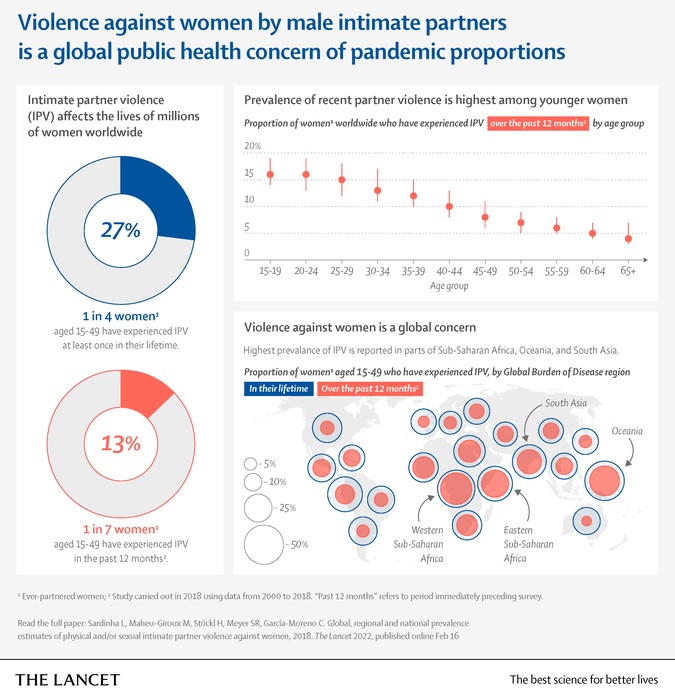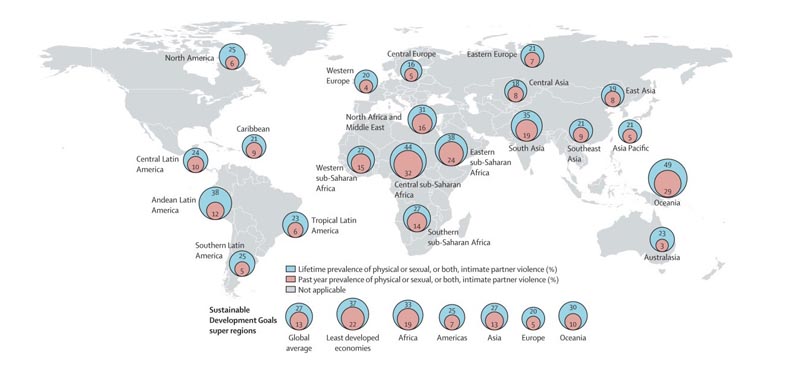More than a quarter of women have experienced intimate partner violence at some point in their lives, according to a new study
|
New research published in The Lancet estimates that more than one in four women have experienced domestic violence during their lifetime. Using data from the World Health Organization’s global database on the prevalence of violence against women, which covers 90% of women worldwide, these new estimates indicate that before the COVID-19 pandemic, 19, 27% of women ages 15 to 49 who have ever had a partner had experienced physical and/or sexual violence from an intimate partner at some point in their lives, with one in seven (13%) experiencing violence recent by an intimate partner (within the last 12 months of the survey).
Research in context
Evidence before this study
In 2013, WHO published the first global and regional estimates of the prevalence of intimate partner physical or sexual violence, or both, and non-partner sexual violence, based on a systematic review and analysis of survey data. existing until 2010. This review has not been updated since then, nor did it systematically search for unpublished reports.
This study was based on 141 studies in 81 countries, conducted between 1990 and 2012, and captured through a systematic review and additional analysis of 54 national data sets. The systematic review had no language restrictions and searched 26 databases using the same search terms for intimate partner violence, non-partner sexual violence, and study designs as the current study.
We included all population-based studies that included an estimate of the prevalence of intimate partner violence or third-party sexual violence, NPSV, or both. Since then, and with the announcement of Sustainable Development Goal (SDG) target 5.2 on the elimination of violence against women, there has been a substantial increase in population-based surveys and studies measuring violence. of intimate partners around the world, and several countries have now conducted multiple surveys.
Added value of this study
This paper presents the first internationally comparable global, regional, and country (or area) prevalence estimates of physical or sexual violence, both lifetime and past year, or both, by male intimate partners against women aged 15–49 who ever had a partner within the SDG reporting period (2015–30). In addition to the comprehensive and systematic searches, consultations with countries led to the identification of additional relevant data. This search led to the inclusion of a total of 366 studies from 161 countries and areas.
Implications of all available evidence
We found that, based on 2000–18 data, more than one in four (27%) ever-partnered women ages 15 to 49 had experienced physical or sexual violence, or both, from an intimate partner since the 2000s. 15 years. One in seven (13%) experienced this violence in the year prior to the survey. The findings support that violence against women by their male intimate partners is a global public health problem affecting the lives of millions of women and their children around the world.
Progress in reducing violence has been slow and countries are not on track to meet the commitments outlined in the SDGs. Strong evidence shows that intimate partner violence is preventable and that targeted investments are required to implement multi-sector, multi-level prevention interventions and to strengthen the response of health and other sectors to intimate partner violence.

Intimate partner violence among ever-partnered women (defined as women who are or have been married, cohabiting, or have a long-term sexual partner) refers to harmful physical, sexual, and psychological behaviors in the context of marriage, cohabitation, or any other form of union. It can have significant short- and long-term impacts on the victim’s physical and mental health, resulting in substantial social and economic costs for governments, communities and individuals.
The United Nations 2030 Agenda for Sustainable Development has called for an end to violence against women in its Sustainable Development Goals (SDG 5.2). This study aims to provide baseline estimates for intimate partner violence against women at global, regional and national levels to help governments monitor their progress towards this goal and inform policies and programs to prevent and respond to violence.
In 2013, WHO published the first global and regional estimates of the prevalence of physical and/or sexual violence by intimate partners and non-partner sexual violence using survey data existing through 2010, finding that one in three women experience physical and/or sexual violence. /or sexual violence by couples and non-couples. Almost one in three (30%) of women experienced physical and/or sexual violence only from their partners.
This new study uses population-based surveys, improved data quality, and updated methods to provide current prevalence estimates of intimate partner violence worldwide, up to and including 2018, and reports that one in four women who ever once had a partner experiences violence from intimate partners alone. The study only estimated physical and sexual violence and the WHO is working to strengthen measures to report harmful psychological behaviors by partners.
This analysis reveals that governments are not in line to meet the goals of eradicating violence against women. “While progress has been made in the last 20 years, it is still extremely insufficient to meet the SDG goal of eliminating violence against women by 2030,” says the study’s lead author, Claudia García-Moreno, of the World Health Organization.
She adds: “Intimate partner violence affects the lives of millions of women, children, families and societies around the world. Although this study was conducted before the COVID-19 pandemic, the numbers are alarming and research has shown that the pandemic exacerbated problems that led to intimate partner violence, such as isolation, depression and anxiety, and drug use. of alcohol, as well as reducing access to support services.
Preventing intimate partner violence from happening in the first place is vital and urgent.
“Governments, societies and communities must pay attention, invest more and act urgently to reduce violence against women, including by addressing it in post-COVID reconstruction efforts.”
The data used in this research comes from the WHO Global Database on the Prevalence of Violence against Women and includes more than 300 eligible surveys and studies conducted between 2000 and 2018. It covers 161 countries and areas, with 2 million women aged 15 years and older, representing 90% of the world’s population of women and girls. The statistical analysis allowed us to calculate the prevalence of intimate partner violence in different age groups, regions and time ranges.
Globally, it is estimated that 27% or approximately one in four women between the ages of 15 and 49 who have ever had a partner have experienced violence from their intimate partner at least once in their lives since the age of 15. Estimates suggest that in 2018, up to 492 million women aged 15 to 49 experienced intimate partner violence in the past 12 months, equivalent to 13% or one in seven women. Because the estimates in this study are based on women’s self-reported experiences and given the sensitive and stigmatized nature of the topic, it is likely that the true prevalence of violence to which these women are subjected from their intimate partners is even greater.

The study also draws attention to the high levels of intimate partner violence experienced by adolescent girls and young women. In the younger age cohort of women (15-19 years), it is estimated that 24% or almost one in four have experienced intimate partner violence at some point in their lives. The prevalence of recent/current intimate partner violence was highest among adolescent girls and young women ages 15 to 19 and 20 to 24 who have ever had a partner, with 16% or one in six experiencing intimate partner violence. in 2018 (in the last 12 months of the survey).
“The high number of young women experiencing intimate partner violence is alarming, as adolescence and young adulthood are important stages of life in which the foundations for healthy relationships are built. The violence these young women experience has lasting impacts on their health and well-being. Intimate partner violence is preventable and more needs to be done to develop and invest in effective community and school-based interventions that promote gender equality and reduce young women’s risk of being subjected to intimate partner violence," says Lynnmarie Sardinha, World Health Organization, the lead author of this article.
Regional variations according to global burden of disease classifications revealed that lifetime prevalence of intimate partner violence among women aged 15 to 49 years was highest in Oceania (49%) and central sub-Saharan Africa (44%). . The regions with the lowest estimates of lifetime prevalence of intimate partner violence were Central Asia (18%) and Central Europe (16%).
These regional patterns were similar in the past 12 months of intimate partner violence prevalence, being highest in central sub-Saharan Africa (32%), Oceania (29%), eastern sub-Saharan Africa (24%), and South Asia (19%). . %).
In general, high-income countries had lower estimated prevalence rates of both lifetime and past-year intimate partner violence among ever-partnered women ages 15 to 49, with regional differences particularly pronounced between regions. high-income and low- and lower-middle-income regions for Intimate Partner Violence in the Past Year.
“These findings confirm that violence against women by their male intimate partners remains a global public health challenge. “Governments are not on track to meet targets to eradicate violence against women by 2030. The authors call for urgent investment in effective multi-sector interventions and a strengthened public health response to address this issue post-COVID-19,” says Claudia García-Moreno.
The authors acknowledge some limitations of the study. These include confidence in the availability and quality of existing survey data on violence against women; Some important gaps remain in the data for some geographic regions and subpopulations, for example, people living with disabilities, indigenous/ethnic minority or migrant women, trans women, and women in same-sex couples for whom data They are currently limited.
The definition of association also varies according to contexts and is based on the definition given in the surveys used. This means that some studies may not have captured all types of association, especially in younger age groups, although the methodology used was, where possible, adjusted for this to minimize underestimation.
In a linked comment, Jessica Leight of the International Food Policy Research Institute (Washington DC, United States), who was not involved in the study, said: “These findings highlight the importance of more carefully analyzing the evolution of intimate partner violence and other related forms of violence directed at girls and women across the life course. “This comprehensive new data should only re-emphasize the urgency of developing, evaluating, and scaling strategies that can target the prevention and reduction of IPV for women around the world, particularly the most vulnerable.”
Interpretation These findings show that intimate partner violence against women was already highly prevalent around the world before the COVID-19 pandemic. Governments are not on track to meet the SDG targets on ending violence against women and girls, despite strong evidence that intimate partner violence is preventable. There is an urgent need to invest in effective multi-sector interventions, strengthen the public health response to intimate partner violence, and ensure it is addressed in post-COVID-19 rebuilding efforts. |
















